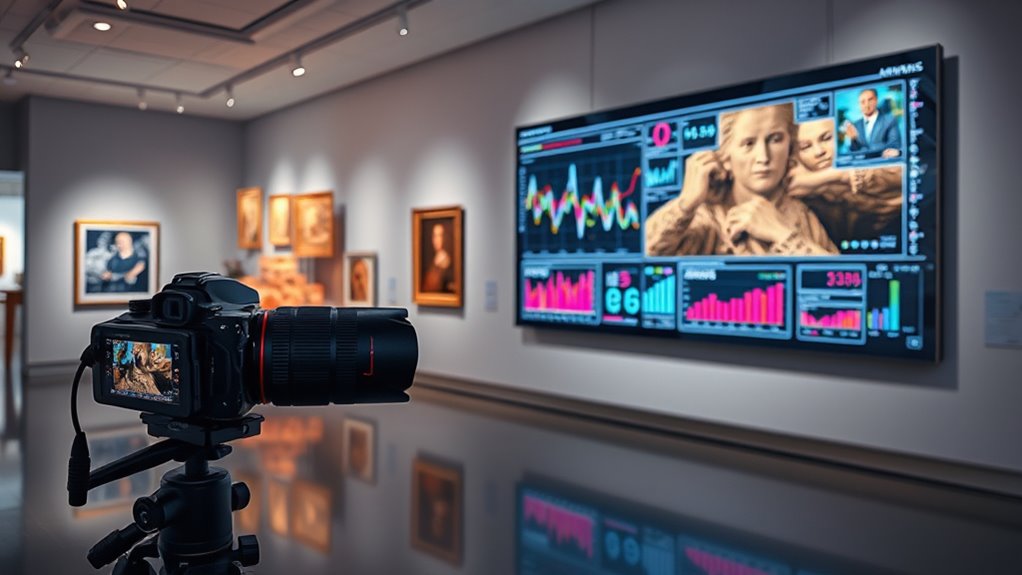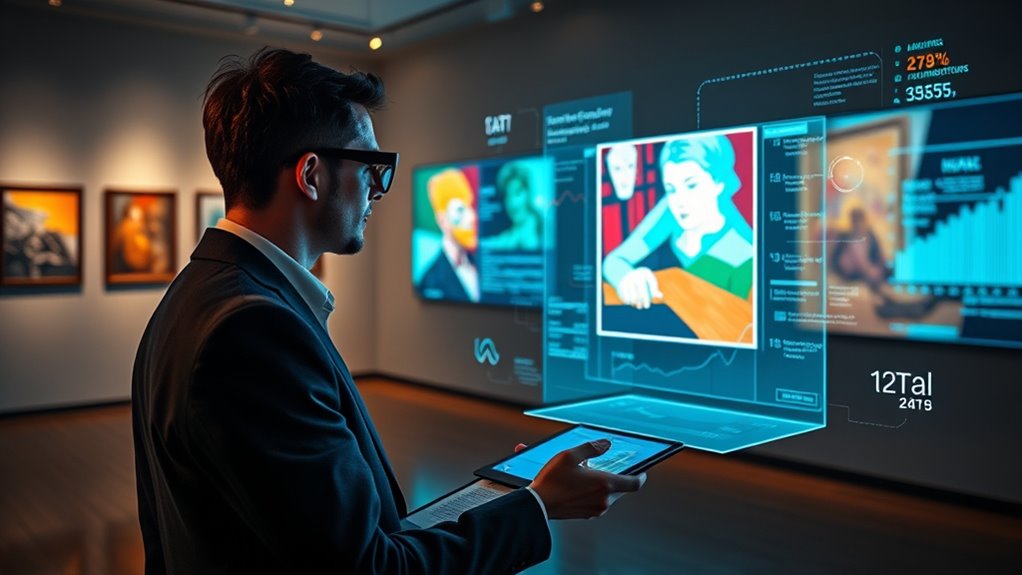Data-driven art investing uses AI and analytics to make smarter decisions. These technologies now evaluate artworks objectively, analyze market trends, and verify authenticity, reducing reliance on subjective opinions. By harnessing detailed image recognition, provenance records, and sales data, you gain clearer insights into an artwork’s true value and future potential. Stay with us to explore how these innovations are shaping smarter investments and opening new opportunities in the art world.
Key Takeaways
- AI-powered image recognition and data analytics enable objective, rapid authentication and valuation of artworks.
- Blockchain and digital provenance records verify authenticity, reducing fraud risks.
- Predictive analytics analyze sales, social media, and market trends to forecast art value fluctuations.
- Visual analytics and pattern recognition uncover artist signatures, stylistic evolution, and hidden details.
- Data-driven tools assist in strategic acquisition, portfolio diversification, and identifying emerging art market opportunities.
The Evolution of Art Valuation Methods

The way we value art has transformed dramatically over time, especially as data and technology have become more integral to the process. Historically, art valuation relied on expert opinions, provenance, and aesthetic judgment, making it subjective and inconsistent. Over the years, approaches shifted toward market-based methods, analyzing auction prices and sales records to determine worth. Today, digital tools and data analytics have revolutionized this process. You can now access extensive databases and use algorithms to assess an artwork’s value more objectively. These methods consider multiple factors—such as artist reputation, historical significance, and market trends—faster and more accurately than ever before. Additionally, the role of color accuracy and other technological advancements in evaluating visual content further enhances the precision of digital art appraisal methods. This evolution enables you to make better-informed investment decisions based on exhaustive, data-driven insights.
How Artificial Intelligence Is Transforming Art Analysis

Artificial Intelligence is revolutionizing how you analyze art by enhancing pattern recognition, making it easier to identify subtle details and styles. It provides objective valuation metrics, reducing guesswork and increasing confidence in assessments. Additionally, AI predicts market trends, helping you make smarter investment decisions based on data-driven insights. Moreover, AI-driven personalization in art analysis tailors evaluations to specific collector preferences, further refining investment strategies.
Enhanced Pattern Recognition
As artificial intelligence advances, it revolutionizes how you recognize and interpret patterns in art. AI algorithms analyze vast image datasets, identifying subtle features that human eyes might miss. These patterns include brushstroke techniques, color palettes, composition styles, and artist-specific signatures. Machine learning models can detect recurring motifs across different works, revealing influences or artistic evolution. This capability allows for recognition of soulmate angel numbers, which can provide additional insights into an artist’s personal symbols or recurring themes. This enhanced pattern recognition helps you categorize artworks more accurately and uncover connections between pieces that are not immediately obvious. By automating detailed visual analysis, AI accelerates the identification of authentic works and potential forgeries. You gain deeper insights into stylistic trends and artist behaviors, enriching your understanding of art history and market dynamics. Ultimately, AI’s pattern recognition sharpens your ability to evaluate and invest in art with greater confidence.
Objective Valuation Metrics
Because subjective judgments often dominate art valuation, AI introduces a new level of objectivity by analyzing quantifiable data. This shift means you can now rely on concrete metrics rather than intuition alone. AI evaluates factors such as provenance authenticity, physical condition, stylistic consistency, and market activity to generate reliable valuations. These metrics help you: 1. Make confident investment decisions grounded in data. 2. Reduce biases that cloud traditional assessments. 3. Spot undervalued artworks with precision. 4. Track changes in an artwork’s worth over time objectively. Additionally, advancements in cybersecurity ensure that data used in AI analysis remains protected from potential breaches.
Predictive Market Trends
Building on objective valuation metrics, AI’s ability to analyze large datasets enables it to identify emerging market patterns and predict future trends in art collecting. By processing sales histories, auction data, and social media activity, AI uncovers shifts in collector preferences and rising artists before they hit mainstream attention. This predictive power helps you anticipate which styles, genres, or artists are poised for growth, giving you a strategic advantage. AI models can spot subtle signals indicating market momentum, such as increasing online engagement or demographic shifts. As a result, you can make more informed acquisition decisions, optimize your portfolio, and stay ahead of market fluctuations. Additionally, ongoing advancements in AI security help ensure the integrity of data used for these predictions, further empowering your investment strategies. This technology transforms art investing from reactive to proactive, empowering you to capitalize on future trends early.
Key Data Sources and Technologies in Art Evaluation

You can leverage art market databases to access extensive sales histories and pricing trends that inform your evaluations. Visual analytics tools help you interpret complex data and identify patterns in artworks and artist performance. Additionally, verifying provenance and authenticating pieces are vital steps that rely on trusted records and technological tools to guarantee value and legitimacy. Drawing inspiration from Bollywood Legends, understanding cultural narratives can also enhance the contextual valuation of artworks.
Art Market Databases
How do collectors and investors determine the value of a piece? They rely on art market databases that compile extensive data, giving you a clear picture of trends and prices. These databases include:
- Auction results, revealing recent sale prices and demand shifts.
- Gallery sales, showing current market preferences.
- Artist archives, tracking career milestones and valuation changes.
- Provenance records, confirming authenticity and historical significance.
- Tuning techniques and modifications, such as performance upgrades, can also influence a piece’s valuation by enhancing its appeal or uniqueness.
Visual Analytics Tools
Visual analytics tools have revolutionized art evaluation by transforming complex data into easily interpretable insights. These tools combine advanced visualization techniques with powerful algorithms, enabling you to analyze large datasets quickly. You can examine patterns in pricing trends, artist popularity, and market fluctuations at a glance. Technologies like heat maps, scatter plots, and interactive dashboards help you identify correlations and anomalies that might otherwise go unnoticed. By integrating data from auction results, gallery sales, and online platforms, these tools provide an all-encompassing view of the art market landscape. They also allow you to filter and customize views, making it easier to assess potential investments or authenticate artworks based on visualized data. Additionally, these tools often incorporate limited-edition artwork data, giving collectors unique insights into exclusive pieces. Overall, visual analytics tools empower you to make more informed, data-driven decisions in art evaluation.
Provenance and Authentics
Provenance and authenticity are foundational to evaluating art investments, and advanced data sources and technologies play a vital role in this process. You can now verify an artwork’s history and legitimacy with remarkable precision. Cutting‑edge tools analyze secure databases, auction records, and digital certificates to trace origins. They use AI algorithms to detect forged signatures or altered documents, providing confidence in authenticity. With these technologies, you uncover hidden stories behind each piece, ensuring confidence in your investments. Additionally, Honda Tuning innovations in engine diagnostics and performance enhancements demonstrate how technological advancements can optimize vehicle capabilities, paralleling how data-driven tools enhance art authentication.
Benefits of Data-Driven Approaches for Collectors and Investors

Data-driven approaches offer significant advantages for collectors and investors by providing clearer insights into an artwork’s value and potential for appreciation. With AI and analytics, you can analyze large datasets to identify trends, market demand, and artist performance more accurately than traditional methods. This allows for more precise market analysis, helping you make informed decisions, reducing risks associated with speculation. Data tools can highlight undervalued pieces or emerging artists, giving you early access to promising investments. Additionally, quantitative insights enable you to track market fluctuations and predict future value shifts. As a result, your investment strategy becomes more strategic and data-backed, increasing your chances of achieving better returns. Overall, leveraging data enhances your ability to evaluate art objectively, making your portfolio more resilient and aligned with market realities.
Challenges and Ethical Considerations in AI-Based Art Valuation

While AI offers powerful tools for valuing artwork, it also introduces significant challenges and ethical concerns that you need to contemplate. First, bias in algorithms can lead to unfair valuations, skewing perceptions of worth. Second, over-reliance on data may overlook intangible qualities like emotional resonance and cultural significance. Third, proprietary models can obscure transparency, making it hard to trust valuations. Fourth, the risk of manipulation increases if malicious actors exploit AI systems for false appraisals. These issues threaten fairness, authenticity, and trust in the art market. As you navigate AI’s potential, you must balance technological advancements with responsibility, ensuring ethical standards guide your decisions and protect the integrity of art valuation.
Future Trends and Opportunities in Tech-Driven Art Investing

As technology continues to evolve, it opens up exciting new opportunities for your investments in art. AI-driven analytics will enhance your ability to identify emerging artists and undervalued works with greater accuracy. Blockchain technology will improve transparency and provenance, reducing fraud and boosting confidence in transactions. Virtual and augmented reality will transform how you experience art, making it easier to access and evaluate pieces remotely. Additionally, machine learning algorithms can predict market trends, helping you make smarter buying and selling decisions. As data becomes more integrated into the art world, you’ll have better tools to diversify your portfolio and manage risks. Embracing these innovations positions you at the forefront of a rapidly changing landscape, revealing new potential in tech-driven art investing.
Frequently Asked Questions
How Does AI Handle Subjective Art Qualities Like Emotional Impact?
AI analyzes subjective art qualities like emotional impact by interpreting patterns and features that evoke emotions, such as color, composition, and brushwork. You can think of it as training algorithms on vast datasets of artwork and viewer reactions to learn what tends to generate certain feelings. While AI can’t truly feel emotions, it recognizes signals linked to emotional responses, helping you assess art’s emotional influence more objectively.
What Are the Limitations of Current Data Sources in Art Valuation?
You should be aware that current data sources in art valuation often lack extensive coverage, especially for emerging artists or niche markets. Incomplete or outdated information can skew results, and reliance on sales data ignores qualitative factors like provenance or emotional impact. Additionally, digital records may be biased or inconsistent, limiting the accuracy of AI assessments. This means you might not get a fully accurate valuation without considering these data limitations.
How Can Biases in Data Influence AI Art Evaluations?
Biases in data can steer AI art evaluations like a crooked compass, leading you astray. If the data favors certain artists, styles, or periods, your AI might overvalue or undervalue artworks based on incomplete or skewed information. This distortion can cause you to overlook emerging talent or misjudge the true worth of pieces. To navigate this, you must guarantee diverse, balanced data sets, keeping your evaluations fair and accurate.
What Role Do Human Experts Play Alongside AI in Art Appraisal?
You, as a human expert, play a pivotal role in art appraisal by providing nuanced insights AI alone can’t grasp. You interpret context, emotional value, and historical significance, ensuring that evaluations are well-rounded. You also validate AI’s findings, catching biases or errors. By collaborating with AI, you enhance accuracy, making your judgment indispensable in the art valuation process, especially when subjective factors are involved.
How Is Data Privacy Maintained in Art Transaction Records?
Like a vault safeguarding treasures, data privacy in art transactions is maintained through encryption, secure servers, and strict access controls. You guarantee that sensitive information remains confidential by implementing advanced cybersecurity measures, anonymizing transaction data, and adhering to legal standards like GDPR. Regular audits and updates act as vigilant guards, protecting your records from breaches, so your art dealings stay private and secure amid the digital landscape.
Conclusion
Imagine walking into an auction house where AI tools act like seasoned guides, revealing hidden value in artworks you might overlook. Data-driven art investing turns this vision into reality, blending technology with intuition. As you embrace these innovations, you’ll navigate the art market with confidence, much like discovering a rare masterpiece waiting to be uncovered. Embrace the future, where data and art converge, opening new horizons for your collection and investments.









